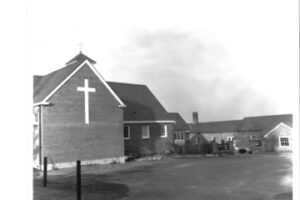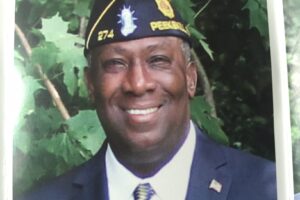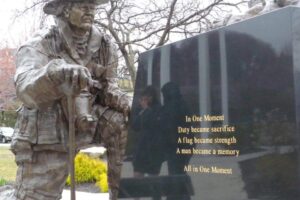Tarrytown and Sleepy Hollow have always had its share of celebrities such as Washington Irving, John C. Fremont, John D. and William Rockefeller, Mark Twain (for a very short period), Jay Gould, and certainly many other millionaire businessmen; and then there was Elsie Janis who was a household name for the first thirty years of the 20th century.
Elsie Janis was born Elsie Bierbower in Columbus, Ohio in 1889.
 She was educated by her governess and private tutors, while being pushed into show business by her overbearing mother, who would become her longtime business manager. Elsie was singing in local church shows by age two. By age five she was part of the Valentine Stock Company that also included Mary Pickford as a child star. When she was ten years old, Elsie was invited by President William McKinley to sing at the White House. By age eleven she was a popular performer on the vaudeville circuit doing song and dance. One of her special gifts was that of mimicry of other famous performers such as Will Rogers, John Barrymore and George M. Cohan. By the time she was fourteen, Elsie was performing on Broadway and starred in six Broadway plays between 1905 and 1917. "The Slim Princess" and "The Lady of the Slipper" were probably her most famous. Her talent was noticed by Irving Berlin, Jerome Kern, and Florenz Ziegfeld with whom she would collaborate in song-writing in later years. Elsie was performing on the London stage at the height of her fame, but left it all to become a Red Cross nurse and to perform for British soldiers about to leave for France at the beginning of WWI.
She was educated by her governess and private tutors, while being pushed into show business by her overbearing mother, who would become her longtime business manager. Elsie was singing in local church shows by age two. By age five she was part of the Valentine Stock Company that also included Mary Pickford as a child star. When she was ten years old, Elsie was invited by President William McKinley to sing at the White House. By age eleven she was a popular performer on the vaudeville circuit doing song and dance. One of her special gifts was that of mimicry of other famous performers such as Will Rogers, John Barrymore and George M. Cohan. By the time she was fourteen, Elsie was performing on Broadway and starred in six Broadway plays between 1905 and 1917. "The Slim Princess" and "The Lady of the Slipper" were probably her most famous. Her talent was noticed by Irving Berlin, Jerome Kern, and Florenz Ziegfeld with whom she would collaborate in song-writing in later years. Elsie was performing on the London stage at the height of her fame, but left it all to become a Red Cross nurse and to perform for British soldiers about to leave for France at the beginning of WWI.
She fell in love with Basil Hallum, a British actor, who was also performing for departing troops. He was later killed in action, and many believed that Elsie never got over his death. When the United States entered WWI in 1917 she followed our troops to France, saying, "I had but one idea, and that was to get to France and do for our boys what I had done for the others — for I thought, if the Tommies liked me in their own land and were surrounded by their families, how would our boys feel, three thousand miles away from home?" Elsie was the first woman ever permitted to perform close to enemy lines on foreign soil during a war. She maintained an exhausting schedule, often performing nine forty-five-minute shows a day. General John J. Pershing was so impressed with her impact on morale that he assigned a car and driver to Elsie. When visiting a hospital ward in France she said, "I went into the wards and tried to make them forget that they had wounds. I could write pages of the bravery of our men, not under fire because that goes without saying, but under real and terrible pain. Whether they had lost one leg or two, whether they would perhaps never see again, the smile was always there for me and my little jokes." She endeared herself to all, and became known as the "Sweetheart of the A.E.F" (the American Expeditionary Force).
In 1916 Elsie Janis bought the Manor House of Philipsburg Manor. She added a tennis court, cultivated a beautiful English garden, and, with her mother, spent a great deal of time buying furniture and refurbishing the venerable old manor house. On returning from France at the end of WWI, Elsie said, "Though all America is home, sweet home, Tarrytown-on-ye-Hudson is where we have put about all of our hard-earned dollars, in the Manor House, built in 1683, and looking its full age — at least in age it does."
After WWI, Elsie toured the U.S. with a group of veterans in a Revue titled, "Elsie: and Her Gang." She returned to Paris and London to perform on stage several times, but engagements became less frequent and Elsie turned to writing. In 1925 she wrote, "If I Know What I Mean," in 1926 she co-authored, "Counter Currents" with Margarite Aspinwall, and "So Far So Good: An Autobiography" in 1933. She appeared in six silent films during the 1920’s, but found it difficult, like so many others, to make the transition from stage to "talking" motion pictures. As result, she tried to again return to the stage. She played the lead in Gershwins’ "Oh Kay" to mixed reviews.
In 1930 her mother died and Elsie married Gilbert Wilson, a stockbroker, sixteen years her junior. She gave lavish parties at the Manor House, often having Douglas Fairbanks, Mary Pickford, Irving Berlin, and other show business celebrities as her guests. She spent money freely, then lost a fortune in the depression years of the early thirties. A serious auto accident in 1935 further depleted her finances. As a result, her personal possessions, and furnishings went up for auction for three days in September 1936. Numerous local residents bid, and won many "treasures." At the same time, The Tarrytown Daily News stated that, "Miss Janis then announced that she would sell Philipse Manor House only for preservation as a historical landmark in Tarrytown…" Elsie said, "The dear old Manor which has been dear in every sense of the word, is the first thing that I am giving up — and I’ve never loved it more." In a letter from Charles Neegaard, Esq., written on September 8, 1936, he states, "Mr. Lawrence Rockefeller talked the whole situation over with her (Elsie Janis), during the present year and John D. Rockefeller, Jr. said that while he was not prepared to take over the entire proposition he would participate substantially and was interested." The Historical Society of the Tarrytowns continued to appeal for funds, and won the full support of John D. Rockefeller, Jr. who purchased the property in 1940. The "Mills" was opened to the public in 1943 and served for several years as the center for the Historical Society, which is now located on Grove Street in Tarrytown.
After selling the Manor House, Elsie and her husband, Gilbert, moved to Beverly Hills, hoping to find work in the motion picture industry. Elsie began a new aspect of her career. She wrote screen plays for motion pictures as well as writing sheet music and songs for some of the movies. As WWII began to approach, Elsie appeared in four patriotic concerts, but they generated only slight public interest. In 1940 Elsie appeared in "Women in War," her last film and her only talkie.
In her later years, Elsie retired, and spent quiet days in Beverly Hills. She was no longer the household name that she was in the beginning of the century. However, in 1963, The Tarrytown Daily News stated that, "The warm feeling that the Tarrytowns had for Miss Janis extended throughout the U. S. She was one of the rare entertainers in American theater that one can truly say was loved by her public." Elsie Janis died on February 26, 1956 with her old childhood friend, Mary Pickford, at her bedside. There, on her night table next to her bed, was a framed photo of her first love, Basil Hallum.







Elsie Janis was believed to have bought from the Easton Machine Company in South Easton, MA within the years 1915 to 1917 a Morse Car, Chauffeur driven Theatre Bodied Design with a toilet seat under the back seat! This was for her mother and her comfort during their Travels. The car was nicknamed “The Pink Tea” because of the very different paint color and upholstery color combination. We think the colors were Pink with Lavender upholstery Or the opposite combination? Whatever happened to that car is unknown but may exist in someone’s car collection in Sleepy Hollow?
If anyone has information about what may have happened to this automobile please contact me by CP 1-508-728-1030 for Historical Insight